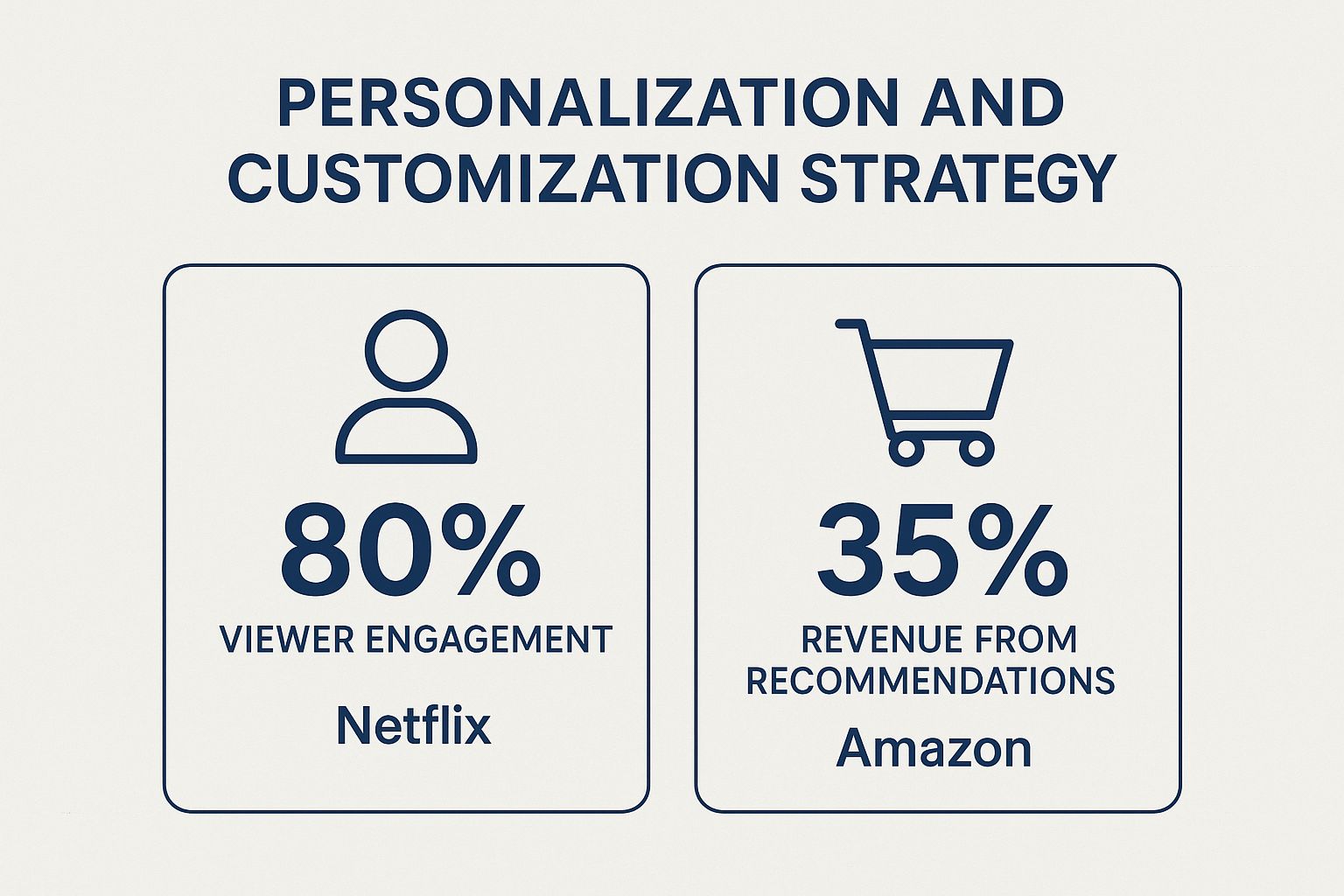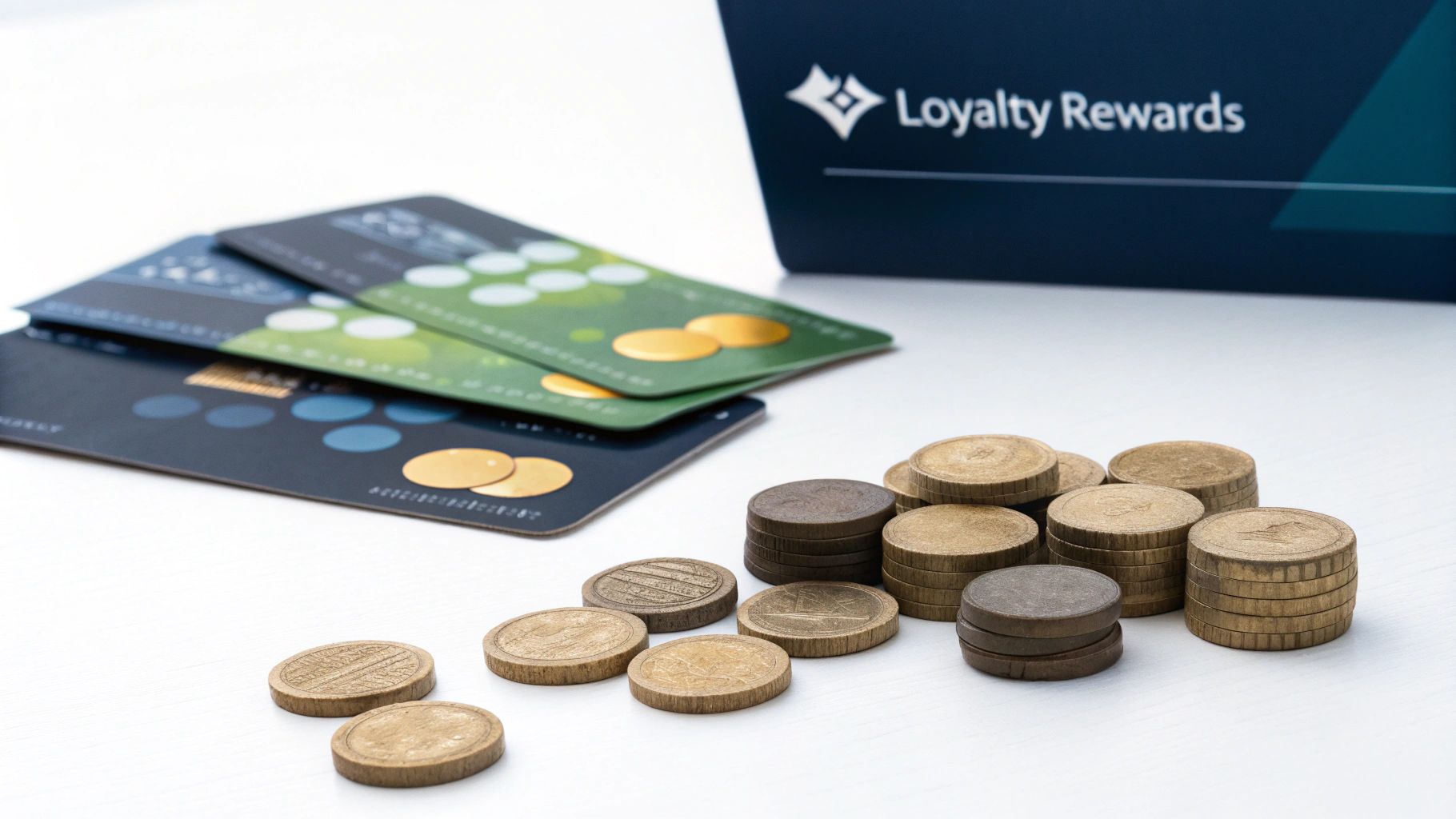10 Proven Customer Retention Strategies to Fuel Sustainable Growth
In a competitive business landscape, acquiring new customers is only half the battle. True, sustainable growth is built on keeping the customers you already have. Neglecting this crucial aspect means constantly refilling a leaky bucket, a costly and inefficient cycle that hampers long-term success. Mastering effective customer retention strategies is no longer a "nice-to-have"; it's a core business imperative for any company aiming for market leadership.
This article dives deep into ten powerful tactics that modern leaders in marketing, product, and customer success are using to combat churn and increase customer lifetime value (LTV). We'll go beyond generic advice, providing a detailed roadmap for implementing proven strategies. Each one is designed to create loyal brand advocates who not only stay with you but also champion your product.
Throughout this guide, we'll explore how technology, particularly AI-powered tools, can supercharge your efforts. You will learn how to transform every user interaction into an opportunity for growth and retention. Get ready to turn your existing customer base into your greatest asset and the primary engine for your company's growth.
1. Deploy Hyper-Personalized Customer Experiences
Hyper-personalization is a sophisticated customer retention strategy that moves beyond basic segmentation. It involves using real-time behavioral data to create individualized communications, product interactions, and user journeys. For modern platforms, this means dynamically adapting the experience to guide each user based on their unique actions and needs, rather than treating everyone the same.
The goal is to make every user feel understood and valued, which significantly accelerates product adoption and demonstrates value faster. When users receive relevant, contextual guidance precisely when they need it, their path to becoming loyal, long-term customers is shortened. For a deeper dive into crafting superior customer interactions, consider these 9 B2B Customer Experience Best Practices.
How AI Drives Hyper-Personalization
AI-powered chat is instrumental in delivering these tailored experiences at scale. For instance, an AI tool like Worknet.ai can monitor a trial user's behavior and proactively offer contextual help. If a user struggles with a specific feature, the AI can surface a relevant tutorial or in-app message, transforming a moment of friction into a learning opportunity. This proactive, personalized support is a powerful driver of retention.
The following infographic highlights the immense business impact of personalization, as pioneered by B2C giants.

These figures from Netflix and Amazon demonstrate that when personalization is done right, it becomes a core driver of both user engagement and revenue.
Actionable Tips for Implementation
- Start with Segmentation: Begin by grouping users based on attributes like company size, user role, or plan type before moving to one-to-one personalization.
- Ensure Data Quality: Integrate data from all touchpoints (CRM, product analytics, support tickets) to build a comprehensive, 360-degree customer view.
- A/B Test Everything: Continuously test personalized elements, from email subject lines to in-app pop-ups, and measure their direct impact on key retention metrics like activation and feature adoption.
2. Implement a Strategic Loyalty Program
A strategic loyalty program is a structured marketing approach that rewards customers for their continued business and engagement. Far beyond simple transactional rewards, modern programs focus on creating emotional connections and a sense of community. By offering points, exclusive benefits, and special recognition, companies can transform repeat buyers into dedicated brand advocates.
This customer retention strategy incentivizes desired behaviors, such as frequent purchases or platform engagement, making customers feel valued for their allegiance. Powerhouses like Amazon Prime and Sephora’s Beauty Insider program demonstrate this perfectly, with members spending significantly more and accounting for the vast majority of transactions. A well-designed program is a powerful engine for predictable, recurring revenue.

How AI Elevates Loyalty Programs
AI-powered chat tools add a dynamic, personalized layer to loyalty programs that static systems cannot match. An AI chatbot can act as a personal concierge for each member, proactively notifying them of point balances, new rewards they've unlocked, or exclusive offers tailored to their purchase history.
For example, if a SaaS user is approaching a new rewards tier, an AI-driven message can congratulate them and highlight the new benefits they are about to receive. This real-time, contextual communication keeps the program top-of-mind and makes participation feel more personal and engaging, directly boosting long-term retention.
Actionable Tips for Implementation
- Align Rewards with Values: Design rewards that go beyond discounts. Offer early access to features, exclusive content, or one-on-one sessions that align with your customers' professional goals.
- Keep It Simple and Transparent: Ensure the process for earning and redeeming points is straightforward and easy to understand. Complexity is a major barrier to participation.
- Combine Transactional and Emotional Benefits: Mix tangible rewards (like account credits) with emotional ones (like public recognition or a "member of the month" feature) to build a deeper connection.
- Leverage Program Data: Use the data collected from your loyalty program to further personalize the entire customer experience, from marketing communications to in-app guidance.
3. Deliver Exceptional Customer Service
An exceptional customer service strategy transforms support from a reactive cost center into a proactive, value-generating engine for loyalty. It involves moving beyond simply solving problems to creating memorable, positive experiences that consistently exceed expectations. This approach, famously championed by companies like Zappos and Ritz-Carlton, builds deep emotional connections that make customers feel valued and understood.

The core principle is to empower support teams to go above and beyond, turning every interaction into an opportunity to strengthen the customer relationship. This builds a reputation for outstanding care, which is one of the most powerful and defensible customer retention strategies available. When customers know they will be treated exceptionally well, they are far less likely to churn.
How AI Elevates Customer Service
AI-powered chat platforms are critical for delivering superior service at scale without sacrificing quality. An AI chatbot can handle routine inquiries instantly, 24/7, freeing human agents to focus on complex, high-value interactions that require empathy and creative problem-solving. This creates a more efficient, responsive support system.
For example, an AI tool can analyze a user's support history and product usage data before a conversation even begins. This allows it to provide the human agent with immediate context, enabling a faster, more personalized, and effective resolution. This seamless blend of AI efficiency and human empathy is the hallmark of a modern, exceptional service strategy.
Actionable Tips for Implementation
- Hire for Attitude: Prioritize candidates with a natural aptitude for empathy, problem-solving, and a positive demeanor. Technical skills can be taught, but a service-oriented mindset is innate.
- Empower Frontline Staff: Give your support agents the autonomy and resources to resolve issues immediately without needing multiple approvals. A famous example is Ritz-Carlton, which empowers employees to spend up to $2,000 to solve a guest's problem.
- Measure Customer Effort: Track the Customer Effort Score (CES) alongside CSAT. Focusing on how easy you make it for customers to get help is a leading indicator of loyalty.
4. Provide Proactive, Value-Based Engagement
A value-based engagement strategy is one of the most effective customer retention strategies because it shifts the focus from selling features to delivering outcomes. This approach centers on continuously demonstrating tangible value through education, resources, and insights that help customers achieve their business goals. Instead of just being a software provider, you become an indispensable partner in their success.
The core principle is to make your brand synonymous with customer achievement. When your resources directly contribute to a customer's growth, they develop deep-rooted loyalty that transcends pricing or feature comparisons. For example, HubSpot's free marketing education and Shopify's business guides create fiercely loyal users who see the platforms as essential to their operations.
How AI Facilitates Value-Based Engagement
AI-powered chat tools excel at delivering value-based engagement at scale. An AI assistant can proactively share relevant content based on a user's role, industry, and in-app behavior. For instance, if an e-commerce manager is exploring your platform’s analytics features, an AI bot can offer a guide on "Interpreting Sales Data to Boost Q4 Revenue," directly connecting the tool to a valuable business outcome.
This proactive, educational support turns your product into a strategic asset. By delivering the right insights at the right time, AI helps users extract maximum value, reinforcing their decision to stay with your service.
Actionable Tips for Implementation
- Define Success Metrics: Work with customers to establish key performance indicators (KPIs) that align with their business objectives, not just your product's usage metrics.
- Create Educational Resources: Invest in a robust library of content, including webinars, tutorials, and best-practice guides that help customers master their craft using your tool.
- Schedule Value Reviews: Implement regular check-ins, like quarterly business reviews, to explicitly demonstrate the ROI and value delivered over the previous period.
- Celebrate Customer Wins: Actively identify and celebrate customer successes. Share their stories in case studies or community forums to inspire others and reinforce value.
5. Build a Thriving Customer Community
A community building strategy is a powerful customer retention approach focused on creating spaces for customers to connect with each other and the brand. This strategy moves beyond simple transactions, fostering a sense of belonging and turning a user base into a loyal ecosystem. By facilitating peer-to-peer support and shared experiences, you create network effects that significantly increase switching costs and deepen product loyalty.
The goal is to build an environment where customers feel like part of something bigger. When users can learn from one another, share successes, and engage with your brand in a meaningful way, their connection to your product becomes more profound. For a SaaS business, this can transform users from passive consumers into active advocates.

Brands like Salesforce with its Trailblazer Community and Peloton with its 90%+ monthly retention rates demonstrate the immense power of community. These platforms are not just about the product; they are about the shared identity and collective experience of their members.
How AI Can Foster Community Engagement
AI-powered chat is an excellent tool for nurturing and scaling community initiatives. An AI assistant can be embedded within your community platform to answer common questions instantly, freeing up human moderators to focus on higher-value engagement. For example, it can proactively connect a new member asking a basic question with a relevant knowledge base article or a seasoned community expert. This AI-driven facilitation makes the community more valuable and accessible for everyone, especially newcomers.
To ensure your customer community is truly thriving and supports retention, explore these community engagement best practices.
Actionable Tips for Implementation
- Start with Champions: Identify your most passionate and engaged customers and invite them to become founding members or moderators. Their initial enthusiasm will set a positive tone.
- Establish Clear Guidelines: Create and enforce clear community rules to ensure a safe, respectful, and constructive environment. Active moderation is key to maintaining a healthy space.
- Drive Regular Engagement: Plan regular events like Q&A sessions with experts, user-led workshops, or exclusive content drops to keep the community active and provide ongoing value.
- Listen and Adapt: Treat your community as a direct line to your user base. Actively listen to their feedback, discussions, and pain points to inform your product roadmap and improve the customer experience.
6. Maintain Proactive and Transparent Communication
A proactive communication strategy is a powerful customer retention approach focused on maintaining regular, valuable contact with users before they even need to ask for help. Instead of waiting for support tickets to roll in, this method involves anticipating customer needs and providing timely updates, educational content, and relevant insights. It’s about building a relationship, not just managing a transaction.
The core goal is to prevent common issues, build trust through transparency, and keep your brand top-of-mind. When customers feel you are invested in their success, like Buffer does with its transparent updates or Mailchimp with its educational courses, they are far more likely to remain loyal. For more ideas, explore these effective customer communication strategies.
How AI Powers Proactive Outreach
AI-powered chat is essential for executing proactive communication without overwhelming your team. An AI assistant can monitor user behavior to identify early signs of struggle or opportunity. For example, if a user repeatedly visits a pricing page but doesn't upgrade, an AI like Worknet.ai can trigger a personalized message offering a demo or highlighting the key benefits of a higher-tier plan.
This transforms communication from a manual, one-to-many broadcast into a targeted, one-to-one conversation. By automating this outreach, you can ensure every user receives relevant information at the perfect moment, nurturing them along their journey and reinforcing the value of your product.
Actionable Tips for Implementation
- Segment Your Audience: Group users based on their lifecycle stage, feature usage, or plan type to ensure every communication is highly relevant.
- Focus on Value: Prioritize educational content, best-practice tips, and feature updates over purely promotional messages to build authority and trust.
- Use Multiple Channels: Employ a mix of in-app messages, emails, and even push notifications, but ensure your core message remains consistent across all platforms.
- Offer Preference Controls: Allow users to easily customize the type and frequency of communications they receive to prevent opt-outs and improve engagement.
7. Establish a Proactive Customer Success Program
A Customer Success Management (CSM) strategy is one of the most powerful customer retention strategies, shifting the focus from reactive support to proactive partnership. This approach assigns dedicated Customer Success Managers (CSMs) to accounts to ensure customers achieve their desired business outcomes with your product. CSMs are responsible for guiding users through onboarding, promoting adoption, and consistently demonstrating value throughout the entire lifecycle.
The core goal is to transform the vendor-customer relationship into a strategic alliance focused on mutual growth. By monitoring customer health and providing strategic guidance, CSMs can preemptively address issues long before they lead to churn. To build a robust framework for this, you must first understand the key performance indicators, which you can explore further in this guide to essential customer success metrics.
How AI Empowers Customer Success Teams
AI-powered chat tools amplify the effectiveness of a CSM strategy by automating routine tasks and providing deep insights. For instance, an AI assistant can monitor product usage patterns to flag accounts with declining engagement or those not utilizing key features. It can then automatically alert the assigned CSM with contextual information, allowing them to intervene proactively with a personalized outreach or a targeted training session. This allows CSMs to manage a larger portfolio of clients more effectively, dedicating their high-touch efforts to the most critical strategic interventions.
Actionable Tips for Implementation
- Define Success Criteria Early: Work with each customer during onboarding to establish clear, measurable goals and what "success" looks like for them.
- Develop Customer Health Scores: Create a scoring system that combines product usage data, support ticket volume, and survey feedback to identify at-risk accounts.
- Build Scalable Playbooks: Document standard procedures and communication templates for common scenarios like onboarding, feature adoption campaigns, and renewal conversations.
- Align Incentives with Outcomes: Tie CSM compensation to customer-centric outcomes, such as product adoption rates and health score improvements, not just renewals.
8. Offer Flexible Pricing and Billing
A flexible pricing and billing strategy is a powerful approach to customer retention that adapts to diverse customer needs. Instead of a rigid, one-size-fits-all model, this strategy offers varied pricing tiers, billing cycles, and payment terms to accommodate different usage patterns, company sizes, and financial situations. This adaptability reduces friction and ensures your pricing can scale alongside your customers' growth.
The core goal is to align the cost of your service with the value customers receive, making it easier for them to justify their continued investment. When customers feel the pricing is fair and grows with their success, as seen with models like Shopify's graduated plans, they are far more likely to remain loyal. This proactive financial alignment is one of the most effective customer retention strategies for long-term partnership.
How AI Can Optimize Pricing Models
AI-powered chat can play a crucial role in managing flexible pricing by providing instant, personalized support. For instance, an AI tool can help a customer understand the benefits of upgrading to a new tier based on their recent product usage, proactively showing them the ROI. If a customer on a usage-based plan is approaching their limit, the AI can alert them and suggest the most cost-effective next step.
This automated, intelligent guidance helps users self-serve and make informed decisions about their subscription, preventing billing-related churn. It transforms potentially confusing pricing questions into clear, value-driven conversations that reinforce customer trust.
Actionable Tips for Implementation
- Offer Clear Upgrade Paths: Design pricing tiers that logically follow a customer's growth trajectory. Make it simple for them to move between plans as their needs evolve.
- Provide Temporary Relief Options: For customers facing financial hardship, consider offering temporary plan downgrades, payment pauses, or discounts to retain them through tough times.
- Use Data to Optimize Pricing: Analyze customer behavior, feature adoption, and support tickets to understand perceived value and adjust pricing tiers accordingly.
- Consider Annual Discounts: Encourage long-term commitment and improve your cash flow by offering a significant discount for customers who opt for annual billing over monthly payments.
9. Create a Robust Feedback Loop for Continuous Improvement
A feedback loop and continuous improvement strategy is a systematic process for gathering, analyzing, and acting on customer input. This customer retention strategy turns passive listening into active, iterative product development, showing users their voices are valued and their needs directly shape the product's evolution. This commitment to customer-driven improvement builds immense loyalty and trust.
By formalizing this process, you demonstrate that your company is not static but a living entity that evolves with its users. This proactive stance is essential for long-term customer retention, as it ensures your product or service remains aligned with customer expectations and solves their most pressing problems. For a deeper look at turning raw data into insights, explore these best practices for analyzing customer feedback.
How AI Powers Effective Feedback Loops
AI-powered chat tools are invaluable for creating and managing a continuous feedback loop. An AI assistant can proactively solicit feedback at key moments, such as after a user successfully completes a new workflow or interacts with customer support. This targeted approach captures high-quality, contextual feedback that is far more useful than generic surveys.
For instance, an AI can ask, "How helpful was that feature for completing your report?" and immediately categorize the response. This automates the collection and initial analysis, allowing your teams to focus on prioritizing and implementing the most impactful suggestions, strengthening your customer retention strategies.
Actionable Tips for Implementation
- Close the Loop: Always communicate back to customers what actions were taken based on their feedback. This validation encourages future participation.
- Prioritize Strategically: Use a framework to score feedback based on factors like customer value, market impact, and alignment with your strategic goals.
- Use Multiple Channels: Capture input from diverse sources like in-app surveys, support tickets, social media, and dedicated community forums to get a holistic view.
- Recognize Contributors: Acknowledge and reward customers who provide valuable, detailed feedback, turning them into evangelists for your brand.
10. Deliver a Seamless Omnichannel Experience
An omnichannel experience strategy ensures customers receive a seamless and consistent brand interaction across all touchpoints, from your website and mobile app to in-person support. Unlike multichannel approaches that operate in silos, an omnichannel strategy integrates these channels, allowing customers to switch between them without losing context or progress. This continuity is a cornerstone of modern customer retention strategies.
The core principle is to meet customers where they are, letting them engage on their preferred platform while maintaining a single, unified brand conversation. When a customer can start a support chat on their laptop and seamlessly continue it on their phone without repeating themselves, they feel understood and respected. This friction-free journey builds trust and loyalty, directly impacting long-term retention.
How AI-Powered Chat Enables a True Omnichannel Experience
AI-powered chat platforms are pivotal in bridging the gaps between different channels. An AI chatbot can serve as the central hub for customer interactions, maintaining conversation history across web, mobile, and even third-party messaging apps. For example, a customer might initiate a query on your website's chatbot, which can then send a follow-up summary via email or a push notification to their app.
This intelligent routing and context-preservation ensure that every interaction adds to a unified customer profile. If a live agent needs to step in, they have the full conversation history available instantly, regardless of where the conversation started. This creates an efficient, high-quality support experience that is a powerful driver of customer satisfaction and retention.
Actionable Tips for Implementation
- Map Customer Journeys: Start by charting all possible customer paths and touchpoints, identifying potential friction points where context is lost between channels.
- Invest in a Unified Data Platform: Use a Customer Data Platform (CDP) to consolidate customer information from all sources into a single, comprehensive view.
- Train for Cross-Channel Support: Equip your support team with the tools and training needed to access and utilize customer information from any channel to provide consistent service.
- Test the Experience: Regularly test your cross-channel flows from a customer's perspective to identify and fix any breaks in the experience. For instance, try starting a cart on mobile and completing it on desktop.
Customer Retention Strategies Comparison
Turn Retention into Your Ultimate Growth Engine
Navigating the landscape of customer retention can feel complex, but the path to success is built on a clear, consistent principle: proactively deliver value. Throughout this guide, we've explored ten distinct yet interconnected customer retention strategies that serve as the building blocks for creating an unshakeable customer base. From the deep, individualized connections forged through hyper-personalization to the collective strength of a thriving customer community, each tactic is a powerful lever for growth.
The core lesson is that retention isn't a passive activity or a single department's responsibility. It's an active, company-wide philosophy. It’s about transforming routine interactions into memorable experiences, anticipating needs before they arise with proactive communication, and demonstrating that you are listening through robust feedback loops. Strategies like offering flexible pricing or establishing a dedicated customer success management program are not just cost centers; they are profound investments in long-term profitability.
Key Takeaways for Immediate Action
To transform these ideas into tangible results, focus on these critical takeaways:
- Retention is Proactive, Not Reactive: Don't wait for cancellation signals. The best customer retention strategies involve engaging customers consistently, offering value through educational content, community initiatives, and exceptional service long before they become at-risk.
- Technology is Your Scalability Partner: Manually executing these strategies across thousands of customers is impossible. AI-powered tools are the essential force multiplier, enabling you to personalize interactions, provide instant 24/7 support, and gather actionable insights at a scale you couldn't otherwise achieve.
- Start Small, Scale Smart: You don't need to implement all ten strategies overnight. Choose one or two that align most closely with your current business challenges. Is your support team overwhelmed? Focus on exceptional, AI-driven customer service. Are your customers not using key features? Double down on value-based engagement and proactive communication.
Your Next Steps to Mastering Customer Retention
The journey from a reactive "churn-fighting" mindset to a proactive "loyalty-building" culture starts now. Begin by auditing your current customer journey and identifying the points of highest friction. Use this analysis to select the most impactful strategy from this list to implement first.
Empower your marketing, product, and customer success teams to collaborate on this initiative. By breaking down silos and uniting around the common goal of customer value, you create a seamless experience that fosters deep loyalty. Remember, retaining a customer is not just about preventing a loss; it's about nurturing an asset. Each retained customer becomes a potential advocate, a source of recurring revenue, and a testament to your brand's commitment to excellence. By mastering these customer retention strategies, you aren't just improving a metric; you are building a resilient, sustainable, and powerful engine for future growth.
Ready to supercharge your customer retention with the power of AI? Worknet.ai Inc provides an advanced AI chat platform designed to help you implement these strategies at scale, from personalizing onboarding to delivering instant, 24/7 support. Discover how you can turn every customer interaction into a loyalty-building opportunity at Worknet.ai Inc.
FAQs
.png)
Lorem ipsum dolor sit amet, consectetur adipiscing elit. Suspendisse varius enim in eros elementum tristique. Duis cursus, mi quis viverra ornare, eros dolor interdum nulla, ut commodo diam libero vitae erat. Aenean faucibus nibh et justo cursus id rutrum lorem imperdiet. Nunc ut sem vitae risus tristique posuere.
Lorem ipsum dolor sit amet, consectetur adipiscing elit. Suspendisse varius enim in eros elementum tristique. Duis cursus, mi quis viverra ornare, eros dolor interdum nulla, ut commodo diam libero vitae erat. Aenean faucibus nibh et justo cursus id rutrum lorem imperdiet. Nunc ut sem vitae risus tristique posuere.
Lorem ipsum dolor sit amet, consectetur adipiscing elit. Suspendisse varius enim in eros elementum tristique. Duis cursus, mi quis viverra ornare, eros dolor interdum nulla, ut commodo diam libero vitae erat. Aenean faucibus nibh et justo cursus id rutrum lorem imperdiet. Nunc ut sem vitae risus tristique posuere.
Lorem ipsum dolor sit amet, consectetur adipiscing elit. Suspendisse varius enim in eros elementum tristique. Duis cursus, mi quis viverra ornare, eros dolor interdum nulla, ut commodo diam libero vitae erat. Aenean faucibus nibh et justo cursus id rutrum lorem imperdiet. Nunc ut sem vitae risus tristique posuere.
Lorem ipsum dolor sit amet, consectetur adipiscing elit. Suspendisse varius enim in eros elementum tristique. Duis cursus, mi quis viverra ornare, eros dolor interdum nulla, ut commodo diam libero vitae erat. Aenean faucibus nibh et justo cursus id rutrum lorem imperdiet. Nunc ut sem vitae risus tristique posuere.
Lorem ipsum dolor sit amet, consectetur adipiscing elit. Suspendisse varius enim in eros elementum tristique. Duis cursus, mi quis viverra ornare, eros dolor interdum nulla, ut commodo diam libero vitae erat. Aenean faucibus nibh et justo cursus id rutrum lorem imperdiet. Nunc ut sem vitae risus tristique posuere.
Lorem ipsum dolor sit amet, consectetur adipiscing elit. Suspendisse varius enim in eros elementum tristique. Duis cursus, mi quis viverra ornare, eros dolor interdum nulla, ut commodo diam libero vitae erat. Aenean faucibus nibh et justo cursus id rutrum lorem imperdiet. Nunc ut sem vitae risus tristique posuere.
Lorem ipsum dolor sit amet, consectetur adipiscing elit. Suspendisse varius enim in eros elementum tristique. Duis cursus, mi quis viverra ornare, eros dolor interdum nulla, ut commodo diam libero vitae erat. Aenean faucibus nibh et justo cursus id rutrum lorem imperdiet. Nunc ut sem vitae risus tristique posuere.
Lorem ipsum dolor sit amet, consectetur adipiscing elit. Suspendisse varius enim in eros elementum tristique. Duis cursus, mi quis viverra ornare, eros dolor interdum nulla, ut commodo diam libero vitae erat. Aenean faucibus nibh et justo cursus id rutrum lorem imperdiet. Nunc ut sem vitae risus tristique posuere.
Lorem ipsum dolor sit amet, consectetur adipiscing elit. Suspendisse varius enim in eros elementum tristique. Duis cursus, mi quis viverra ornare, eros dolor interdum nulla, ut commodo diam libero vitae erat. Aenean faucibus nibh et justo cursus id rutrum lorem imperdiet. Nunc ut sem vitae risus tristique posuere.

.svg)


.webp)
.webp)
.webp)




